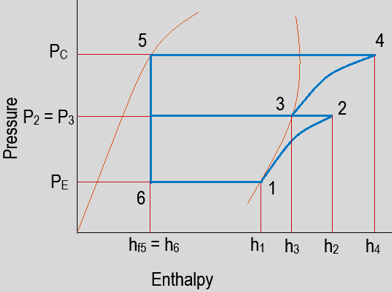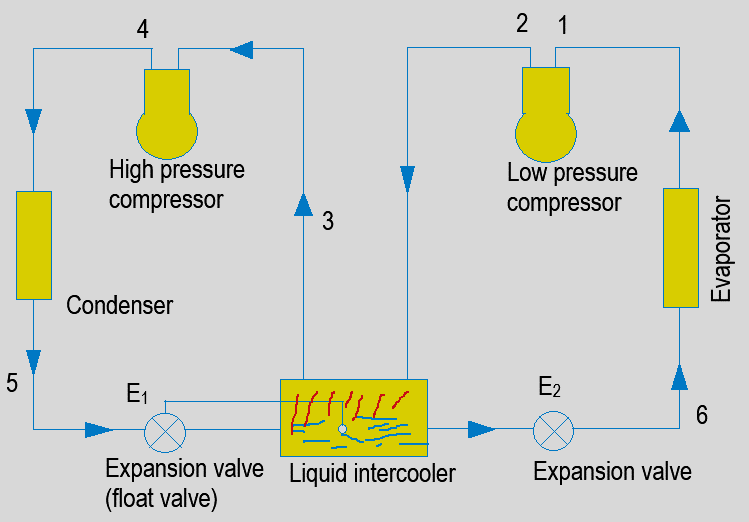This set of Refrigeration Multiple Choice Questions & Answers focuses on “Two/Multi Stage Compression with Liquid Intercooling – 2”.
1. Why multi-stage or compound VCR with intercooler is used?
a) To improve C.O.P.
b) To decrease the refrigeration effect
c) To increase work
d) To increase leakage loss
View Answer
Explanation: By expanding the refrigerant very close to the saturated liquid state refrigeration effect can be improved. And if the refrigerant is compressed very near to the saturated vapor line by using compression in more stages with intermediate intercooling, work can be reduced. Increase in refrigeration effect and decrease in work leads to improve the C.O.P. of the system.
2. What is the purpose of using intercooler?
a) To increase the cost of the compressor
b) To reduce the volumetric efficiency
c) To re-heat superheated refrigerant
d) To cool the superheated refrigerant
View Answer
Explanation: Intercooler is used to cool the superheated refrigerant till the saturated vapor line. The superheated refrigerant leaving the first compressor is cooled by suitable method before entering the second compressor. This type of cooling is known as intercooling.
3. What does process 1-2 and 3-4 represent?

a) Evaporation
b) Compression
c) Condensation
d) Expansion
View Answer
Explanation: Process 1-2 and 3-4 represent compression. This type of compression is isentropic compression, which is carried out in two stages. The first compression is carried out in low-pressure compressor and then compressed in the high-pressure compressor.
4. What does process 2-3 represent?

a) Evaporation
b) Compression
c) Condensation
d) Intercooling
View Answer
Explanation: Process 2-3 represent intercooling or de-superheating. Intercooling is carried out to bring the refrigerant to the saturated vapor line before the second stage of compression. Intercooling results in effective compression in the high-pressure compressor resulting in the reduction of the overall work done.
5. What do PC and PE represent?

a) Evaporator and expansion pressure
b) Compression and expansion pressure
c) Condenser and evaporator pressure
d) Intercooling pressure
View Answer
Explanation: PC is for condenser pressure. The pressure at which latent heat is rejected from the refrigerant and converting vapor form to liquid form. PE is for evaporator pressure. The pressure at which latent heat of vaporization is absorbed from the medium and phase change from liquid to vapor is carried out. Attaining and maintaining these pressures is essential for the smooth operation of the cycle.
6. What is the relation between m1, m2, and m3?

If m1 = mass of refrigerant passing through the evaporator
m2 = mass of refrigerant passing through the condenser
m3 = mass of liquid evaporated in the intercooler
a) m3 = m1 + m2
b) m3 = m1 – m2
c) m3 = m2 – m1
d) m3 = m1 / m2
View Answer
Explanation: The high-pressure compressor will compress the mass of refrigerant discharging from the low-pressure compressor (m1) and the mass of liquid evaporated in the liquid intercooler during intercooling or de-superheating of superheated vapor refrigerant from the low-pressure compressor. So, the mass of liquid evaporated in the intercooler is equal to the difference between the mass of refrigerant passing through the condenser and the mass of refrigerant passing through the evaporator, from the diagram.
Hence, m3 = m2 – m1.
7. What is the ratio of the mass of refrigerant flowing through condenser and mass of refrigerant flowing through the evaporator, i.e., m2 / m1?

If m1 = mass of refrigerant passing through the evaporator
m2 = mass of refrigerant passing through the condenser
a) h2 – h6 / h3 – hf5
b) h1 – h6 / h1 – hf5
c) h2 – h3 / h1 – hf5
d) h2 – h4 / h1 – hf5
View Answer
Explanation: As the mass flowing through the respective systems is given. An intercooler is an isolated system. So, by considering the thermal equilibrium for the liquid intercooler we get,
The heat taken by the liquid intercooler = Heat given by the liquid intercooler
m2 hf5 + m1 h2 = m1 h6 + m2 h3
m2 (h3 – hf5) = m1 (h2 – h6)
m2 / m1 = h2 – h6 / h3 – hf5.
8. What is the value of C.O.P. for the following arrangement?


a) m1 (h1 – hf5) / m1 (h2 – h1) – m2 (h4 – h3)
b) m1 (h1 – hf5) / m1 (h2 – h1) + m2 (h4 – h3)
c) m1 (h1 – hf5) / m1 (h2 – h1)
d) m1 (h1 – hf5) / m2 (h4 – h3)
View Answer
Explanation: C.O.P. = Refrigeration effect / work
Hence, by taking the help of above diagrams,
R.E. = Heat absorbed in the evaporator
= mass flowing through the evaporator x enthalpy change
= m1 (h1 – hf5) as, hf5 = h6
Work = Work done by low-pressure compressor + Work done by high-pressure compressor
= mass of refrigerant flowing through the low-pressure compressor x enthalpy change + mass of refrigerant flowing through the high-pressure compressor x enthalpy change
Work = m1 (h2 – h1) + m2 (h4 – h3)
Hence, C.O.P. = m1 (h1 – hf5) / m1 (h2 – h1) + m2 (h4 – h3).
9. Why is such a type of arrangement used in ammonia plants?
a) High latent heat of vaporization
b) Low latent heat of vaporization
c) Medium latent heat of vaporization
d) High toxicity
View Answer
Explanation: In the case of ammonia, total power requirement will decrease. Because the mass of liquid evaporated during intercooling is extremely small due to the high latent heat of vaporization. The constant entropy lines of ammonia become very flat in the superheat region. Thus, this type of arrangement is used in ammonia plants due to less power requirement.
Sanfoundry Global Education & Learning Series – Refrigeration & Air Conditioning.
To practice all areas of Refrigeration, here is complete set of 1000+ Multiple Choice Questions and Answers.
If you find a mistake in question / option / answer, kindly take a screenshot and email to [email protected]
- Check Refrigeration & Air Conditioning Books
- Practice Mechanical Engineering MCQs
- Check Mechanical Engineering Books
- Apply for Mechanical Engineering Internship
